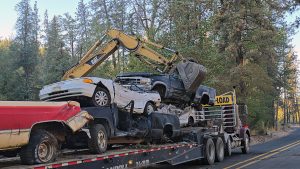UO students take on monumental task with Tamastslikt
By Wil Phinney for the CUJ
After two months of research, a group of University of Oregon honors students have narrowed potential sites in Oregon City where they think five Cayuse men were buried or reburied after they were hanged for the death of missionary Marcus Whitman. Whitman’s wife, Narcissa, and 11 others were killed as well but the five men were indicted only for the murder
of Marcus Whitman. Recent tribal generations have not been able to determine the location of their burials but students in the UO colloquium have given members of the
Confederated Tribes of the Umatilla Indian Reservation (Confederated Tribes) reason to believe the five bodies could be located. “While the five Cayuse men hanged
in 1850 in Oregon City have come to be called “the Cayuse Five” in recent years, we must remember their names and the importance of each of their lives to their families and our Tribes, then and now,” said Bobbie Conner, director of Tamástslikt Cultural Institute (Tamástslikt), the museum and archive repository for the Confederated Tribes. The five men’s names are: Ti’ílaka’aykt, Tamáhas, ’Iceyéeye Cilúukiis, K’oy’am’á Šuumkíin, Łókomus. Conner continued, “Contemporary descendants Les and Armand Minthorn have been stalwart in their efforts to find and honor their ancestors. The Honors class is one of three projects related to the Cayuse Five.” On June 3, 172 years to the day since the public execution of the Cayuse Five, 18 Clark Honors College students presented their findings at the UO Many Nations Longhouse. Among those in attendance were CTUIR elders Les
Minthorn and Andy Dumont, Cultural Resource Committee member Woodrow Star, Tamástslikt staff and UO native students. In addition to the student reports, Tamástslikt staff accepted five boxes of archival and library material from the family of the-late Ronald Lansing, professor of law and the author of Juggernaut, a historical narrative of the trial that took place in Oregon City during the last week of May 1850. The CTUIR presented gifts of appreciation to the class including professors Moffitt and Arnett and to the Lansing family. A cougar hide was given to Les Minthorn who carries the name of his ancestor, K’oy’am’á Šuumkíin, “cougar shirt”. Marcus Whitman was killed on Nov. 29, 1847. Two and a half years later the five Cayuse men, accompanied by two other Cayuse headmen, presented themselves to federal officials. The Five were shackled by federal troops who took them to Oregon City, which was then the capital of the Oregon Territory, where they were tried, convicted, and executed in a public exhibition. In their statements, the Cayuse Five asserted their innocence and only came to federal officials to recount what they knew of the deaths at Whitman Mission. The students were part of a “real-world investigation,” which was, and is, a collaboration with Tamástslikt. Conner was instrumental in getting the student effort underway. The class – Searching for the Cayuse Five – started April 1 with a busload of 16 students traveling from the UO campus in Eugene to Oregon City up the Columbia River to present-day Celilo and Tamástslikt. They spent the following day at the Whitman Mission National Historic Site at Weyíilet, west of present-day Walla Walla. Students were accompanied by Howie Arnett, UO professor of Indian law and counsel to the Confederated Tribes of
Warm Springs; Michael Moffitt, Phil Knight-endowed professor, and Conner. In Oregon City, CTUIR anthropologist Dr. Jennifer Karson Engum, and Oregon City Public Works Director
John Lewis, and city planner Christina Robertson-Gardiner met with students at McLoughlin Promenade, a city park that provides views of the Willamette River, Willamette Falls and an estimated location of the hanging site. The hanging scaffold was erected in an area that became the Blue Heron Mill, which is now owned by the Confederated Tribes of Grand Ronde and is in downtown Oregon City. At Whitman Mission, students heard testimony from seven Cayuses and from former Whitman Mission superintendent Timothy Nitz before touring the grounds. Karson Engum provided the class with documents, clippings, and oral histories that CTUIR staff had accumulated over the years, which gave them a starting point for more investigation. For two months students pored over information – church and legal records, oral histories, genealogy, and mapping. Existing trial records were scrutinized to understand what happened between the time when the men were taken into custody and when they were hanged. Karson Engum communicated with students throughout the course to clarify sources, references, and perspectives. With the help of guest historians, anthropologists, geologists and geographers, students attempted to narrow the initial list of potential sites. By mapping the current area with overlaid historical diagrams, accounts of the execution that mention the bodies being taken by handcart and buried near a creek west of the city could be given a modern context. Students looked at old land records to try to determine who owned which plots and when. Two of the students spent more than 24 hours digging through Lansing’s Juggernaut notes. One account in Lansing’s boxes included a 1937 statement from a man whose father was present at the execution and burial. As a small boy his father showed him the burial site several times. He provided a detailed description of where his father told him the Cayuse were buried. His description included directions by footage, such as when he wrote: “Proceed from this unmarked point south 150 feet…” His account also included logistical markers, such as when he wrote that the site was “about 10 feet north of a forked white fir tree 20 inches in diameter … and to the south end of a row of scrubby fruit trees …” Said Moffitt, “This may not be a case of searching for physical remains. We wish that we could offer the Tribes a simple answer, and we cannot. Our team has spent countless hours over the last nine weeks, digging and challenging, exploring and questioning, compiling, and re-examining. We have been down rabbit holes. We have gotten excited. We have faced down despair. We have held each other up. We have held each other accountable. We have learned, and we have learned about what we do not know.” The students discounted two cemeteries and a location near a suspension bridge on the east side of Oregon City. Nitz and Tamástslikt threw out another, reducing to two the number of potential sites. Other factors also played a part in the students’ search efforts. For example, one document relating to a federal permitting process for a city building says “the most likely burial site” does not take into consideration the effect of flooding and erosion over the 150 years since the burial of the five Cayuse men … Over years [the burials] could have been moved due to area floods or erosion.” The report writer said he understood there had been at least seven floods over the last century and a half. In designing the course, Moffitt said he wanted to do something with students that “would be of benefit to students and to one of the tribes here in Oregon.” Moffitt’s course description hinged in part upon conversations with fellow academic Arnett, who had worked previously with Conner at Tamástslikt, who suggested the idea of students working to find the graves of the Cayuse Five. “We have worked hard. All of us. And I am unspeakably proud of these students and all they have accomplished. We also know that there is much work yet to be done. We recognize that the decisions about possible next steps are to be made by the Tribe. We would welcome the chance to continue to work with Tamástslikt in some capacity, if that would be of interest,” Moffitt said. Conner said the next research priority will be working with the departments of Oregon City and Clackamas County governments, and continuing students, to identify possible motivation for relocation, including timing. “We have a mind-blowing amount to follow up on with this material. And more work to do in a more focused future,” Conner said. Moffitt agreed. “The fact that we do not collectively know the burial sites of the Cayuse Five stands in the way of the prospect of repatriation, of justice, of reconciliation, or whatever else we who are living may decide is the wisest course of action,” said Moffitt. Conner concluded, “The five executed men were closely related. Three were brothers and two were cousins. They are not forgotten and this work must continue for as long as is necessary.”



